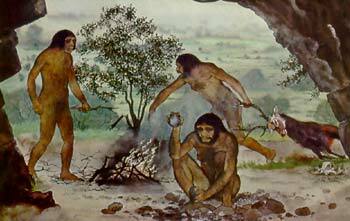The lives of our ancestors is the object of work by researchers from different areas, mainly, archaeologists, biologists, geologists and paleontologists.
In an attempt to discover what the way of life was like, these professionals throw themselves on traces that have resisted the action of time, such as cave paintings, utensils, among other objects.
The first period that is known about human life on Earth is the Prehistory.
It is an era that spans millions of years since the appearance of human existence until the invention of writing.
To facilitate the studies of such a long time span, three divisions were stipulated:
- Paleolithic (Chipped Stone Age): from the emergence of mankind to 8000 a. Ç.
- Neolithic (Polished Stone Age): from 8000 to. Ç. up to 5000 a. Ç.
- Age of Metals: 5000 a. Ç. to the emergence of writing (approximately 3500 a. Ç.)
At first, let's limit ourselves to the study of Paleolithic Period.
Index
- Division of History - Paleolithic Period
- Paleolithic Characteristics
- fire discovery
Division of History - Paleolithic Period
The study of the Paleolithic Period was facilitated by the division into three phases, namely:
- Lower Paleolithic: the first species of hominids that appeared on the African continent;
- Middle Paleolithic: Neanderthal phase;
- Upper Paleolithic: when men were forced to live in caves.
Paleolithic Characteristics
This is the longest period of Prehistory and its main characteristic is the use of tools made by man himself.
It was common, then, to use tools such as staffs, spears and axes, among other instruments made with wood, bones and stone.

The individuals' diet was based on fish, animals, fruits, roots and leaves.
Another strong feature is the posture nomadic of the men of that time. As they basically depended on nature to survive, they had to move in search of food and water.
Thus, their dwellings were temporary, like caves, crevices between rocks and huts built with branches and leaves of trees.
As you can see in the image below, the houses were quite rustic, due to their temporary use profile.

What were Paleolithic men called?
The scientific names given are Australopithecus, homo habilis, homo erectus,homo sapiens, Neanderthal man and Cro-Magnon man.
Popularly, it is said that individuals from this period were called cavemen due to the need to live, as the name implies, in caves to protect themselves from the cold.
How was the economy at that time?
As this was a very rudimentary time, it can be said that the economy was based on subsistence.
- Free Online Inclusive Education Course
- Free Online Toy Library and Learning Course
- Free Online Math Games Course in Early Childhood Education
- Free Online Pedagogical Cultural Workshops Course
Everything they harvested was used for the survival of the group, with no production aimed at commerce.
Another important point is that the tools manufactured were for collective use, not individual.
Initially, men had not yet developed techniques for creating their own weapons. So they selected sharp stones and rubbed them on the ground until their tip became sharper.
The same procedure was applied with bones and wood.
Hunting and fishing techniques were improved around 30,000 BC. Ç. through the creation of the bow and arrow. It was also there that the first cave paintings appeared.
How did people organize themselves?
Individuals organized themselves into groups led by the strongest and most experienced.
The men were responsible for fishing, hunting and protecting the group. Women were responsible for taking care of their children and preparing food.
The groups shared tools and the use of rivers, lakes and forests, in addition to helping each other with the collection of products for subsistence.
How did people communicate in the Paleolithic Period?
In the Paleolithic, communication was not based on speech. Therefore, individuals resorted to some noises, however, the greatest expression was in the so-called cave paintings.

These are drawings made on the walls of their caves through which they exchanged experiences, marked time and gave directions about hunting, fishing and other aspects of daily life.
fire discovery
The men of the Paleolithic Period were responsible for the discovery that would bring intense transformations in the coming eras: the discovery of fire!
The estimate is that it started to be controlled in the east africa approximately 500,000 years ago. From then on, it was possible to cook food, heat up, light and thus better protect oneself from the predators.

Its production had two bases. The first, more rudimentary, consisted of rubbing two stones on dry straw. With the spark, men produced fire by burning the straw.
In the second, the subject rotated a stick over a hole in a piece of dry wood. The heat generated by the movement was transferred to the straw and started the fire.
Were there rituals in the Paleolithic Period?
Oh yes, absolutely! In that period, funeral and religious rituals were already performed.
Evidence of the former is in ceramic pots found by archaeologists containing personal effects and remains.
Religious rituals, in turn, began to be practiced after the discovery of fire.
See more:
- History timeline
- Pleistocene Period: Facts about the Last Ice Age
- List of Exercises on Prehistory
- List of exercises on the Paleolithic period
- List of exercises on the Neolithic period
The password has been sent to your email.


